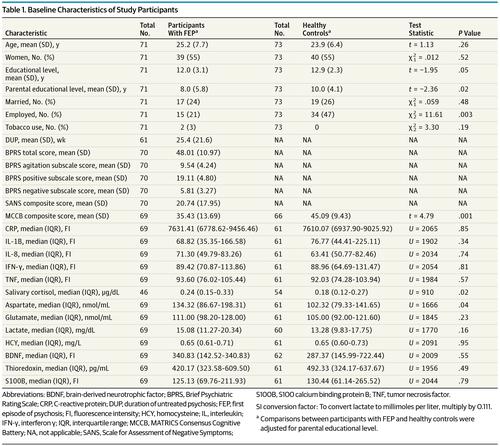JAMA Psychiatry ( IF 22.5 ) Pub Date : 2018-04-01 , DOI: 10.1001/jamapsychiatry.2017.4595 Donald C. Goff 1, 2 , Botao Zeng 3 , Babak A. Ardekani 1, 2 , Erica D. Diminich 4 , Yingying Tang 5 , Xiaoduo Fan 6 , Isaac Galatzer-Levy 7 , Chenxiang Li 8 , Andrea B. Troxel 8 , Jijun Wang 5

|
Importance Duration of untreated psychosis (DUP) has been associated with poor outcomes in schizophrenia, but the mechanism responsible for this association is not known.
Objectives To determine whether hippocampal volume loss occurs during the initial 8 weeks of antipsychotic treatment and whether it is associated with DUP, and to examine molecular biomarkers in association with hippocampal volume loss and DUP.
Design, Setting, and Participants A naturalistic longitudinal study with matched healthy controls was conducted at Shanghai Mental Health Center. Between March 5, 2013, and October 8, 2014, 71 medication-naive individuals with nonaffective first-episode psychosis (FEP) and 73 age- and sex-matched healthy controls were recruited. After approximately 8 weeks, 31 participants with FEP and 32 controls were reassessed.
Exposures The participants with FEP were treated according to standard clinical practice with second-generation antipsychotics.
Main Outcomes and Measures Hippocampal volumetric integrity (HVI) (an automated estimate of the parenchymal fraction in a standardized hippocampal volume of interest), DUP, 13 peripheral molecular biomarkers, and 14 single-nucleotide polymorphisms from 12 candidate genes were determined.
Results The full sample consisted of 71 individuals with FEP (39 women and 32 men; mean [SD] age, 25.2 [7.7] years) and 73 healthy controls (40 women and 33 men; mean [SD] age, 23.9 [6.4] years). Baseline median left HVI was lower in the FEP group (n = 57) compared with the controls (n = 54) (0.9275 vs 0.9512; difference in point estimate, −0.020 [95% CI, −0.029 to −0.010]; P = .001). During approximately 8 weeks of antipsychotic treatment, left HVI decreased in 24 participants with FEP at a median annualized rate of −.03791 (–4.1% annualized change from baseline) compared with an increase of 0.00115 (0.13% annualized change from baseline) in 31 controls (difference in point estimate, −0.0424 [95% CI, −0.0707 to −0.0164]; P = .001). The change in left HVI was inversely associated with DUP (r = −0.61; P = .002). Similar results were found for right HVI, although the association between change in right HVI and DUP did not achieve statistical significance (r = −0.35; P = .10). Exploratory analyses restricted to the left HVI revealed an association between left HVI and markers of inflammation, oxidative stress, brain-derived neurotrophic factor, glial injury, and markers reflecting dopaminergic and glutamatergic transmission.
Conclusions and Relevance An association between longer DUP and accelerated hippocampal atrophy during initial treatment suggests that psychosis may have persistent, possibly deleterious, effects on brain structure. Additional studies are needed to replicate these exploratory findings of molecular mechanisms by which untreated psychosis may affect hippocampal volume and to determine whether these effects account for the known association between longer DUP and poor outcome.
中文翻译:

在首次发作性精神病的初始抗精神病药物治疗期间,海马萎缩与未治疗的精神病病程和分子生物标志物的关联
重要性 未治疗的精神病(DUP)的持续时间与精神分裂症的不良预后相关,但是导致这种关联的机制尚不清楚。
目的 确定在抗精神病药物治疗的最初8周内是否发生海马体积减少以及它是否与DUP相关,并检查与海马体积减少和DUP相关的分子生物标志物。
设计,设置和参与者 在上海心理健康中心进行了自然主义的纵向研究,并选择了与之相对应的健康对照。在2013年3月5日至2014年10月8日之间,共招募了71位未接受过药物治疗的非情感性首发精神病(FEP)患者和73位年龄和性别相匹配的健康对照组。大约8周后,重新评估了31位FEP参与者和32位对照。
暴露 FEP参与者根据标准临床实践接受了第二代抗精神病药的治疗。
主要结果和测量方法 从12个候选基因中确定海马体积完整性(HVI)(对感兴趣的标准化海马体积中实质部分的自动估计),DUP,13个外围分子生物标记和14个单核苷酸多态性。
结果 完整样本包括71名FEP个体(39名女性和32名男性;平均[SD]年龄为25.2 [7.7]岁)和73名健康对照者(40名女性和33名男性;平均[SD]年龄为23.9 [6.4])年)。与对照组(n = 54)相比,FEP组(n = 57)的基线左中位HVI较低(0.9275对0.9512;点估计值的差异为-0.020 [95%CI,-0.029至-0.010];P = .001)。在大约8周的抗精神病药物治疗期间,FEP的24名参与者的左HVI下降,中位数年化率为-.03791(相对于基线的年度变化为–4.1%),而31岁时的增高率为0.00115(相对于基线的0.13%年度变化)对照(点估计差异,-0.0424 [95%CI,-0.0707至-0.0164];P = .001)。左HVI的变化与DUP呈负相关(r = -0.61;P = .002)。尽管右HVI的变化与DUP之间的相关性未达到统计学显着性,但对右HVI的观察结果相似(r = -0.35;P = .10)。仅限于左HVI的探索性分析显示,左HVI与炎症,氧化应激,脑源性神经营养因子,神经胶质损伤和反映多巴胺能和谷氨酸能传递的标记之间存在关联。
结论与相关性 较长的DUP与初始治疗期间海马萎缩加剧之间的关联表明,精神病可能会对大脑结构产生持续的,可能有害的影响。需要进一步的研究来重复这些探索性的分子机制探索性发现,通过这些探索性发现,未经治疗的精神病可能会影响海马体体积,并确定这些影响是否解释了DUP延长与不良预后之间的已知关联。











































 京公网安备 11010802027423号
京公网安备 11010802027423号